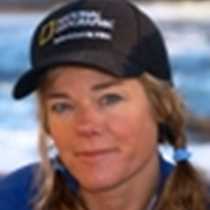Cabo San Lucas
At dawn we rounded the Cape Region, crossed the Tropic of Cancer and officially entered the tropics today. Our first stop was Cabo San Lucas—one of the fastest growing areas in Baja and a jumping off point for bird watching and snorkeling at a lovely sandy beach called Playa Chilenos. The birdwatchers were treated to a Cassin’s kingbird, yellow rumped warblers and an endemic gray thrasher while the snorkelers swam amongst golden trevally, giant hawkfish, yellowtail surgeonfish, parrotfish, and even an octopus. This will be the most tropical snorkeling spot of the trip.
After reboarding the ship, we headed for Gorda Banks. With calm seas, no wind and clear skies, we couldn’t have asked for more perfect viewing conditions. It wasn’t long before a group of six humpbacks were spotted, breaching in the distance. As we edged closer, an amazing mating display began to play out. One male repeatedly lunged his head up and down right next to the others. Such displays are believed to be a means of asserting dominance among a group of males whilst in pursuit of a female. Several of the whales made such power exhalations upon surfacing they nearly sounded like roars. Naturalist Mike Greenfelder got a good look at the undersides of two of the whales’ flukes and from their distinct markings, he determined they were the same two individuals he’d spotted here in another group of six humpbacks back in January of ‘05. These waters are undeniably a favorite mating and calving spot for these long-finned, graceful beauties.
Not to be upstaged by those athletic and amorous humpbacks however, several mobula rays also decided to put on a spectacular show. These rays, similar in appearance to the giant Pacific manta, brought audible gasps from us all as they repeatedly flew out of the water, performed mid-air somersaults and landed with celebratory splashes off either side of the ship.
In the late afternoon we learned about one of the ocean’s strangest creatures, the giant ocean sunfish or Mola mola, as well as the remarkable Tagging of Pacific Pelagics project (TOPP). TOPP employs satellite technology to tag and track more than 20 species of large animals, including tuna, shark, sunfish, squid, leatherback sea turtles and seabirds, across the North Pacific. The project is uncovering the secret lives of these elusive creatures and helping to identify hotspots for conservation as well as recording vital oceanographic information critical to understanding the dynamics of the Eastern Pacific ocean.
The day ended with a gorgeous sunset that filled the sky with pink and orange and glazed the ocean surface in gold. Following dinner, we had a lively and fascinating conversation about the state of the world ocean, the global environment and what can be done to both raise awareness and inspire action.
At dawn we rounded the Cape Region, crossed the Tropic of Cancer and officially entered the tropics today. Our first stop was Cabo San Lucas—one of the fastest growing areas in Baja and a jumping off point for bird watching and snorkeling at a lovely sandy beach called Playa Chilenos. The birdwatchers were treated to a Cassin’s kingbird, yellow rumped warblers and an endemic gray thrasher while the snorkelers swam amongst golden trevally, giant hawkfish, yellowtail surgeonfish, parrotfish, and even an octopus. This will be the most tropical snorkeling spot of the trip.
After reboarding the ship, we headed for Gorda Banks. With calm seas, no wind and clear skies, we couldn’t have asked for more perfect viewing conditions. It wasn’t long before a group of six humpbacks were spotted, breaching in the distance. As we edged closer, an amazing mating display began to play out. One male repeatedly lunged his head up and down right next to the others. Such displays are believed to be a means of asserting dominance among a group of males whilst in pursuit of a female. Several of the whales made such power exhalations upon surfacing they nearly sounded like roars. Naturalist Mike Greenfelder got a good look at the undersides of two of the whales’ flukes and from their distinct markings, he determined they were the same two individuals he’d spotted here in another group of six humpbacks back in January of ‘05. These waters are undeniably a favorite mating and calving spot for these long-finned, graceful beauties.
Not to be upstaged by those athletic and amorous humpbacks however, several mobula rays also decided to put on a spectacular show. These rays, similar in appearance to the giant Pacific manta, brought audible gasps from us all as they repeatedly flew out of the water, performed mid-air somersaults and landed with celebratory splashes off either side of the ship.
In the late afternoon we learned about one of the ocean’s strangest creatures, the giant ocean sunfish or Mola mola, as well as the remarkable Tagging of Pacific Pelagics project (TOPP). TOPP employs satellite technology to tag and track more than 20 species of large animals, including tuna, shark, sunfish, squid, leatherback sea turtles and seabirds, across the North Pacific. The project is uncovering the secret lives of these elusive creatures and helping to identify hotspots for conservation as well as recording vital oceanographic information critical to understanding the dynamics of the Eastern Pacific ocean.
The day ended with a gorgeous sunset that filled the sky with pink and orange and glazed the ocean surface in gold. Following dinner, we had a lively and fascinating conversation about the state of the world ocean, the global environment and what can be done to both raise awareness and inspire action.




